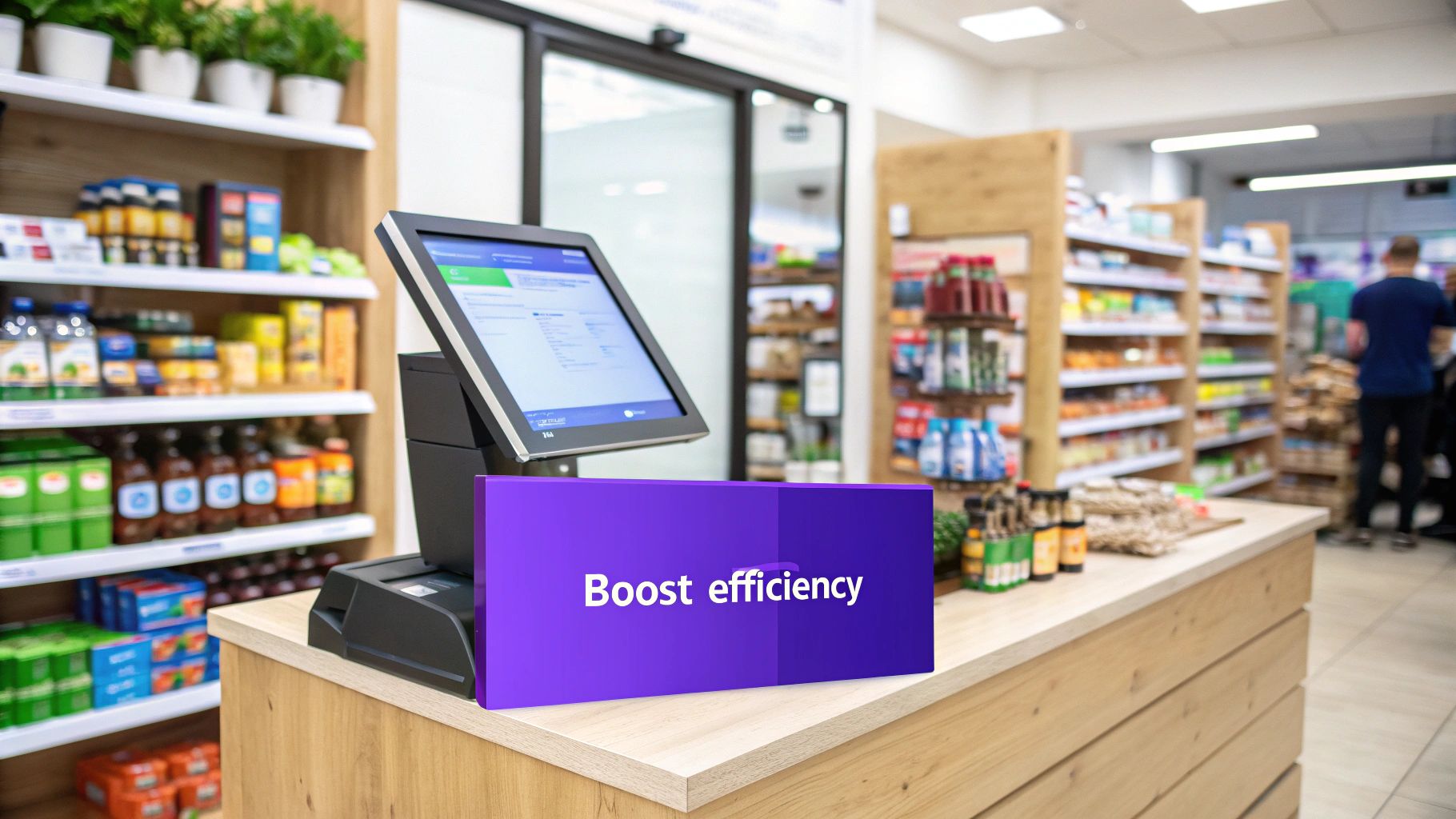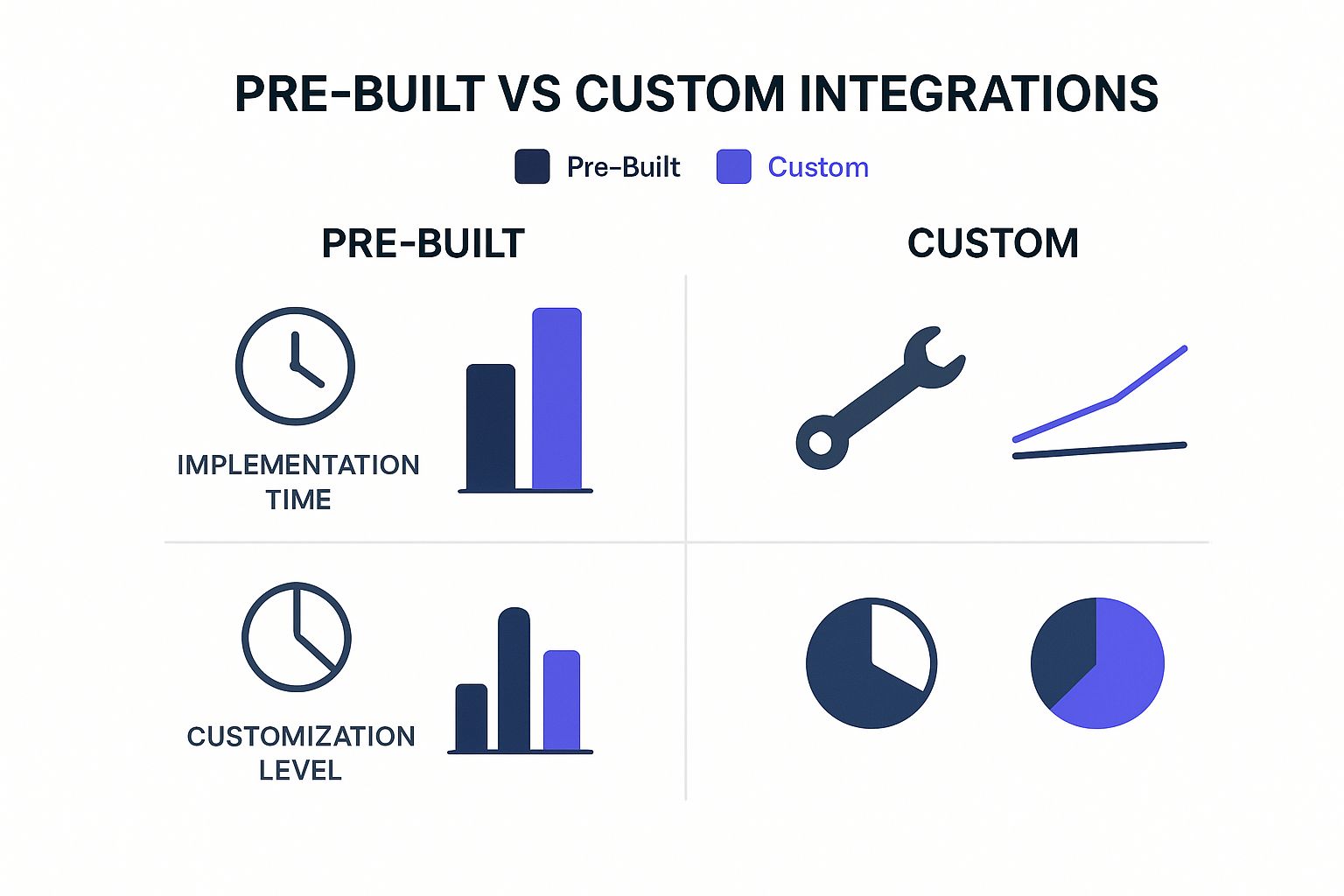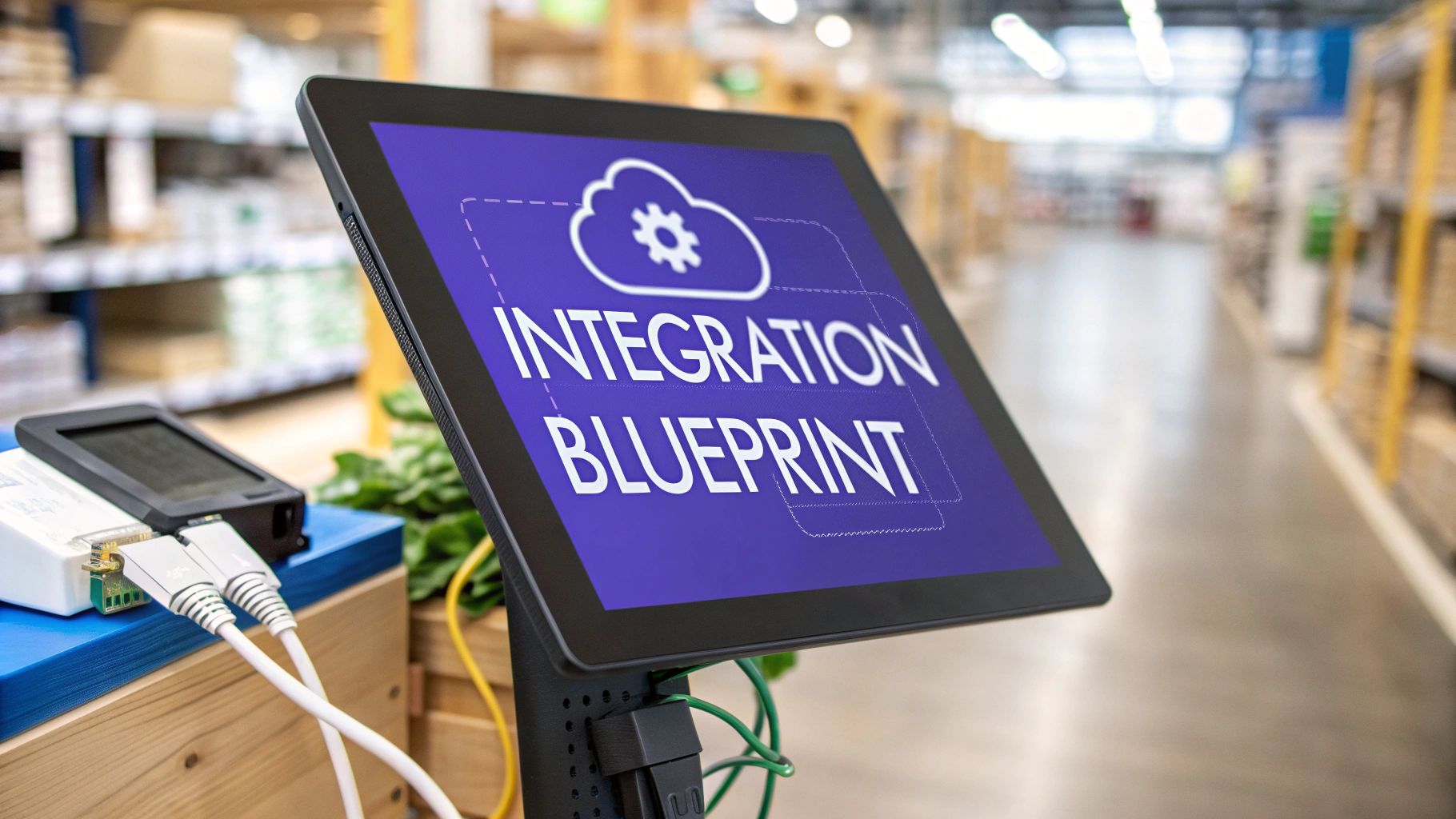Demystifying Ecommerce Platform Integration
Connecting the different parts of your online business is what ecommerce platform integration is all about. Imagine a well-oiled machine: your website, mobile app, social media, inventory management system, payment gateways, and even your email marketing tools, all working together seamlessly. This interconnectedness allows for smooth information flow between systems, streamlining operations and increasing efficiency.
Imagine a customer placing an order on your website. That information automatically updates your inventory, triggers a shipping notification, and sends a personalized thank you email, all without manual input. Instead of juggling multiple dashboards and spreadsheets, you have a single, unified view of your business.
The Power of Connected Systems
This integration offers significant advantages. It eliminates data silos, those isolated pockets of information that can lead to inaccuracies and inefficiencies. Automation frees up valuable time and resources, allowing your team to focus on strategic initiatives instead of repetitive tasks.
The benefits extend beyond internal operations. Perhaps the most crucial advantage is an improved customer experience. Integrating your platforms allows you to create personalized shopping journeys, offer consistent branding across all touchpoints, and provide a seamless checkout process. This fosters customer loyalty and encourages repeat business.
The Growing Importance of Integration
Ecommerce platform integration isn’t just a beneficial feature; it’s becoming essential in today’s competitive market. Online shopping has exploded, resulting in a dramatic increase in ecommerce businesses. Current estimates suggest there are approximately 2.77 billion online shoppers globally, about 33% of the world's population. This number is projected to reach 2.86 billion by 2026.
With over 28 million ecommerce stores competing for customers, seamless integration is crucial for efficient operations and consistent customer experiences across all channels. Want to delve deeper into these stats? Explore this topic further.
Key Considerations for Successful Integration
A robust integration strategy requires careful planning and execution. Businesses need to consider their specific needs, budget, and technical capabilities. Choosing the right integration solutions, from APIs and middleware to dedicated integration platforms, is also critical.
Successful integration requires a phased approach, prioritizing the systems that will deliver the biggest impact. This might involve integrating your website with your inventory management system first, then connecting your payment gateway and shipping provider. A strategic approach ensures integration efforts contribute to long-term growth and success.
The Business Impact of Integrated Commerce Systems

Successfully integrating your ecommerce platform delivers real, measurable results. It's about building a connected system that works together to boost efficiency and drive business growth. This translates to noticeable improvements in key areas of your operations.
Enhanced Inventory Efficiency
One of the most immediate benefits of integration is better inventory management. Having a real-time view of your inventory across every sales channel helps minimize stockouts and prevents overstocking. This directly impacts your bottom line by reducing storage costs and ensuring you have the right products available when customers are ready to buy. Connecting your Point of Sale (POS) System software with your online store, for example, provides a single, accurate view of inventory, preventing discrepancies and increasing sales.
Faster Fulfillment Speeds
Integration streamlines your order processing and fulfillment. Automated workflows kick into gear as soon as an order is placed, speeding up picking, packing, and shipping. This means faster delivery times for your customers, leading to higher satisfaction and increased loyalty. This speed is crucial in the current ecommerce landscape where customers value quick and dependable shipping.
Personalized Customer Experiences
A unified view of customer data offers incredible opportunities for personalization. By integrating systems like your CRM and marketing platforms, you develop a comprehensive understanding of each customer. This allows for highly targeted marketing campaigns, personalized product recommendations, and tailored communication, all of which build stronger customer relationships and drive sales.
To illustrate the potential return on investment (ROI) that proper ecommerce platform integration can offer, let's examine a comparison of business operations with and without integration.
ROI Benefits of Ecommerce Platform Integration
This table presents the quantifiable benefits businesses can expect from implementing proper ecommerce platform integration across different aspects of operations.
| Benefit Category | Without Integration | With Integration | Typical Improvement |
|---|---|---|---|
| Inventory Management | Stockouts, Overstocking, Manual Counts | Real-time visibility, Automated Replenishment | Reduced Inventory Costs by 10-20% |
| Fulfillment Speed | Manual processes, Delays | Automated workflows, Faster shipping | Decreased Fulfillment Time by 20-40% |
| Customer Experience | Generic messaging, Limited personalization | Targeted campaigns, Personalized recommendations | Increased Conversion Rates by 5-15% |
| Operational Efficiency | Manual data entry, Repetitive tasks | Automated processes, Reduced errors | Lowered Administrative Costs by 15-25% |
| Business Intelligence | Limited data analysis, Reactive decisions | Data-driven insights, Proactive strategies | Improved Decision-Making and Profitability |
As this table demonstrates, businesses that integrate their ecommerce platforms experience significant improvements across various key metrics. From inventory cost reduction to increased conversion rates, the advantages of integration are clear.
Streamlined Operations and Reduced Costs
Integrating your various business systems eliminates manual data entry and automates repetitive tasks. This simplifies operations and significantly reduces administrative overhead. Automated workflows minimize errors and improve data accuracy, which results in more efficient processes and substantial cost savings. This frees up valuable time to focus on strategic initiatives and engaging with your customers.
Improved Business Intelligence
Integrated systems act as a central hub for data collection and analysis. This wealth of data provides valuable insights into customer behavior, sales trends, and product performance. Businesses can then use this information to make informed decisions related to marketing, product development, and overall business strategy.
Seamless Expansion
A well-integrated ecommerce platform sets the stage for future growth. Adding new sales channels, expanding into new markets, or launching new products becomes much simpler when your systems are interconnected. This scalability allows your business to adapt and grow without having to rebuild your entire technology infrastructure, enabling agile growth and rapid responses to market changes. This adaptability is key to long-term success in the dynamic world of ecommerce.
Building Your Ecommerce Integration Architecture

A strong ecommerce integration architecture is essential for online business success. It's the connecting framework for all your systems, from your online store and inventory management to payment gateways and marketing platforms. This network allows for seamless data flow and automation, boosting efficiency and growth. As you develop your architecture, consider the power of data insights for making strategic decisions. This article will explore those aspects, as well as offer guidance on building a successful system. For a deeper dive into data-driven decision-making, check out this helpful resource: Data-Driven Decision Making.
Essential Components of Your Integration Ecosystem
Several key components make up a robust integration architecture. APIs (Application Programming Interfaces) are the crucial messengers, enabling communication between different systems. Think of them as digital bridges, transferring data back and forth. Middleware then steps in as a translator, ensuring compatibility between different APIs and smoothing the data exchange. Finally, integration platforms offer centralized control and management of all integrations. These platforms simplify complex processes and offer a single view of your data.
Prioritizing Your Integrations
Not all integrations are equally important. Some will offer greater business impact than others. Focus on integrating the systems that will deliver the most substantial benefits first. For example, connecting your inventory management system with your online store can significantly reduce stockouts and overstocking, leading to immediate cost savings.
Also, consider the complexity of each integration. Begin by connecting simpler systems. This builds momentum and provides valuable experience before tackling more complex projects. This phased approach minimizes disruption and ensures a smoother transition, especially for key functions like order processing and customer profiles.
Connecting Critical Functions
Effective ecommerce platform integration links several crucial business functions. These include:
- Inventory Management: Keep inventory updated in real-time across all sales channels.
- Order Processing: Automate order fulfillment and shipping.
- Customer Profiles: Develop unified customer profiles to personalize marketing efforts.
- Fulfillment Operations: Make warehouse operations and logistics more efficient.
- Payment Systems: Secure and efficient payment processing is vital.
- Marketing Platforms: Use customer data for targeted campaigns.
Connecting these functions creates a unified ecosystem optimizing every step of the customer journey, improving the customer experience and driving business growth. The US ecommerce platform market underscores the importance of choosing the right integrated solutions to effectively capture market share. Shopify dominates this market, holding approximately 30% usage among websites employing ecommerce technologies. This demonstrates the preference for platforms with comprehensive integration capabilities, allowing merchants to manage inventory, payments, shipping, and marketing from a single interface. For more detailed statistics, visit this resource.
Cloud-Based vs. On-Premise Integration
Choosing between cloud-based and on-premise integration is a significant decision. Cloud-based solutions offer flexibility and scalability, ideal for rapidly growing businesses. On-premise solutions provide greater control and security, often preferred by larger enterprises with sensitive data. The best choice depends on your specific business needs and resources.
A well-planned ecommerce integration architecture is dynamic and constantly evolving. Regularly evaluate your integrations and make adjustments as your business grows and changes. This continuous improvement process keeps your systems aligned with your goals and delivers maximum value.
Conquering Mobile and Social Commerce Integration

Today's shoppers expect smooth experiences, whether they're on their phones, scrolling through social media, or browsing an online marketplace. This presents a significant challenge for e-commerce businesses. Your e-commerce platform integration strategy needs to account for this new reality.
Seamlessly Integrating Mobile and Social
A successful integration strategy links your mobile app, social selling platforms, and marketplaces with your existing e-commerce setup. This creates a connected ecosystem that is essential for consistent data, accurate inventory, and unified pricing.
Imagine a customer adding an item to their cart on their phone and later purchasing it on their laptop. A well-integrated system ensures a smooth transaction. Without it, you risk inventory errors and frustrated customers.
Mobile and social commerce have dramatically changed e-commerce integration. Mobile commerce now represents 57% of total e-commerce sales, generating about $2.07 trillion globally in 2024. This data underscores the need for consistent experiences and data accuracy across all platforms. Inconsistent information can negatively impact customer satisfaction and, ultimately, sales. For a deeper dive into these statistics, check out this blog post: What is Ecommerce Integration?.
Strategies for Consistent Product Data and Pricing
Accurate and consistent product data is essential. This includes detailed product descriptions, clear images, correct pricing, and up-to-date availability.
Real-time inventory visibility is also crucial. Customers need to see what's in stock, regardless of how they're shopping. This prevents overselling and minimizes backorders, leading to happier customers. Finally, maintaining unified pricing across all platforms prevents confusion and builds trust.
Building Comprehensive Customer Profiles
Integration allows you to create detailed customer profiles by tracking interactions across devices and platforms. This data is invaluable for personalized marketing.
By understanding customer preferences and past purchases, you can offer tailored product recommendations and targeted promotions. This boosts engagement and drives sales. Cross-channel data offers valuable insights into customer behavior, allowing you to refine your marketing strategies.
Prioritizing Mobile and Social Integration
Prioritizing your integration efforts requires careful planning. Focus on the channels your target audience uses most and the ones that offer the highest potential for revenue. Analyze customer behavior to see how they interact with your brand across different platforms.
This data-driven approach ensures that your integrations align with your business goals and deliver the best return on investment. For some businesses, social commerce might be the key focus. For others, mobile app integration will be more critical. The right approach depends on your customer base and market.
Effective e-commerce platform integration isn't simply about connecting systems; it's about building a smooth, personalized shopping experience that meets the needs of today's mobile and social shoppers.
Choosing Integration Solutions That Actually Deliver
Finding the right integration solution for your ecommerce platform can be a daunting task, given the sheer number of options. This section offers a practical guide for evaluating and selecting integration tools that align with your business needs, technical skills, and growth plans. We'll explore various approaches like custom development, iPaaS (Integration Platform as a Service) platforms, native connectors, and middleware, providing an honest assessment of the pros and cons of each.
Key Evaluation Criteria
Choosing the right integration solution starts with understanding the key factors involved. Consider these crucial aspects:
- Implementation Complexity: How much technical expertise and time is needed for setup and configuration?
- Ongoing Maintenance: What resources are required long-term to keep everything running smoothly?
- Scalability: Can the solution adapt as your business expands and data volume increases?
- Total Cost of Ownership: Look beyond the initial price tag and consider ongoing licensing, maintenance, and upgrade costs.
A thorough evaluation of these factors is essential for a sustainable, cost-effective integration strategy. This often-overlooked step can make all the difference in your integration success.
Comparing Integration Approaches
Each integration approach has its own set of advantages and disadvantages. Custom development offers complete control and flexibility but demands significant development work. iPaaS platforms like Zapier provide user-friendly interfaces and pre-built connectors but may have limitations for highly complex integrations. Native connectors, sometimes offered by specific platforms, simplify integration with certain systems but can be less flexible. Middleware solutions bridge the gap between different systems, increasing compatibility but adding another layer of technical complexity.
The infographic below illustrates key differences between pre-built and custom integrations, focusing on implementation time, maintenance, and customization.

As shown, pre-built integrations are quicker to implement and easier to maintain but offer less customization. This makes them suitable for simpler integration needs. Custom solutions, however, cater to unique and complex requirements.
To further illustrate the differences, let's look at a comparison table:
To help you visualize the key differences, here's a table summarizing each approach:
Ecommerce Integration Solution Comparison: A comprehensive comparison of different integration approaches including features, costs, implementation timelines, and best-fit scenarios.
| Integration Solution | Best For | Typical Implementation Time | Relative Cost | Scalability | Maintenance Requirements |
|---|---|---|---|---|---|
| Custom Development | Complex, unique needs | Months | High | High | High |
| iPaaS Platforms | Simple to moderate integrations, non-developers | Days to weeks | Low to moderate | Moderate | Low |
| Native Connectors | Specific platform integrations | Days | Low | Limited | Low |
| Middleware Solutions | Connecting disparate, legacy systems | Weeks to months | Moderate to high | High | Moderate |
This table highlights the trade-offs between cost, implementation time, and the level of customization and scalability offered by each solution. Choosing the right approach depends heavily on your specific needs and resources.
Building a Phased Implementation Roadmap
A phased approach to integration is crucial. Begin by identifying the integrations that offer the most significant business value and are the easiest to implement. For instance, connecting your online store with your inventory management system through a streamlined integration can automate stock updates and prevent overselling.
A typical phased approach might start with integrating your online store and inventory management system. This provides a quick win by enhancing inventory accuracy and reducing manual tasks. Later phases could involve integrating your CRM, email marketing platform, and other key systems.
Choosing the Right Fit for Your Business
The best integration solution depends on your specific circumstances. A small business with limited technical resources might choose an iPaaS platform with its user-friendly interface and pre-built connectors. A larger enterprise with complex integration needs might opt for custom development or a robust middleware solution for greater flexibility and control.
Regardless of the chosen solution, proper implementation is key. Thorough testing, data cleansing, and staff training are essential for success. By carefully evaluating your options and implementing a phased approach, you can ensure your ecommerce integrations deliver on their promise, optimizing operations, and driving business growth.
Implementation Strategies That Prevent Integration Failure
Successfully integrating an ecommerce platform involves more than simply selecting the right software. A well-defined implementation plan is just as critical, as even the best platforms can underperform without one. This section provides practical advice for implementing integrations that generate real value.
Essential Preparation Steps
Before diving into the technical aspects of implementation, crucial preparatory steps must be taken.
-
Data Cleansing: Begin with accurate and consistent data. Inaccurate or incomplete data can create significant issues during and after integration. This means identifying and rectifying any errors, inconsistencies, and duplicates present in your current data.
-
System Documentation: Comprehensive documentation of your current systems and processes is essential. This serves as a roadmap, guiding the integration process, identifying potential conflicts, and ensuring smooth data transfer. Good documentation is also valuable for troubleshooting.
-
Stakeholder Alignment: All involved teams (sales, marketing, operations, IT) must understand the integration goals and their individual roles in the process. This shared understanding fosters collaboration and minimizes resistance to the changes.
These initial steps are fundamental to a successful integration, reducing disruptions and creating a smoother transition.
Proven Implementation Approaches
With the groundwork in place, the technical implementation can begin. Consider these proven approaches:
-
Phased Rollout: Avoid attempting to implement everything at once. A phased rollout, beginning with the most important systems, minimizes disruptions and allows for issue resolution before they affect the entire system. For example, start by integrating inventory management, then proceed to order processing, and finally, marketing automation.
-
Thorough Testing: Rigorous testing is paramount. Before launching, conduct thorough testing, including unit tests, integration tests, and user acceptance testing. This helps identify and resolve any technical issues or data inconsistencies early on.
-
Managed Data Migration: Migrating data between systems requires a structured approach to ensure data integrity and minimize downtime. This includes validating data accuracy post-migration.
-
Smooth Transition Period: Plan for a post-implementation transition period. Provide ample training to your team on the newly integrated systems and offer continuous support during the initial rollout. This allows your team to adapt to the new workflows and minimizes potential disruptions.
These strategies, along with careful planning and execution, significantly reduce the risk of integration failure. Selecting the right tools is also important, and you can research options like the best affiliate software for SaaS.
Monitoring and Continuous Improvement
After implementation, ongoing monitoring and a commitment to continuous improvement are crucial. Establish clear Key Performance Indicators (KPIs) to measure the integration's effectiveness on your business. Relevant metrics might include order fulfillment speed, inventory turnover rate, and customer satisfaction scores. Regularly review these KPIs and adjust strategies as necessary to optimize performance.
For further insights, read our article on How to Master Customer Retention. Implementing these strategies greatly improves the likelihood of a successful ecommerce platform integration. By prioritizing meticulous planning, careful execution, and continuous monitoring, your integrations can deliver tangible business value and contribute to your long-term growth.
Future-Proofing Your Ecommerce Technology Stack
The ecommerce landscape is in constant flux. New technologies emerge, customer expectations shift, and innovative sales channels appear, requiring businesses to remain agile. This means your ecommerce platform integration strategy needs to be adaptable and robust, ready to handle future developments without requiring a complete system rebuild.
Adapting to the Changing Ecommerce Landscape
Forward-thinking retailers are embracing flexible integration strategies. Rather than relying on rigid, point-to-point integrations, they are constructing composable commerce architectures. This involves using modular components that can be easily connected, disconnected, and rearranged as needed. Think of it like building with LEGO bricks – you can easily create new structures by rearranging existing pieces. This adaptability is essential for responding to new payment gateways, the growth of social commerce platforms like Facebook, and other advancements.
You might be interested in: How to master ecommerce subscription management.
The Rise of Real-Time Synchronization
Today's customers expect instant information and service. They want real-time inventory visibility, up-to-the-minute order tracking, and personalized product suggestions. This makes real-time synchronization between your ecommerce platform and other business systems no longer a desirable feature, but a core requirement. For instance, when a customer adds an item to their online shopping cart, real-time synchronization instantly updates inventory counts across all sales channels, preventing overselling and guaranteeing a smooth customer journey.
AI-Powered Data Orchestration
Artificial intelligence (AI) is increasingly important in ecommerce platform integration. AI-driven tools can automate data mapping, detect potential integration problems, and optimize data flow. This automation minimizes the need for manual adjustments, freeing up your team to focus on high-level strategies. It also boosts the speed and accuracy of data synchronization, streamlining operations and improving strategic decision-making.
Building a Future-Proof Foundation
How can you develop an integration strategy built to last? Here are some crucial factors to consider:
-
Prioritize Flexibility: Select integration solutions that offer easy modification and reconfiguration.
-
Embrace APIs: Application Programming Interfaces (APIs) are fundamental for connecting different systems. Make sure your platform and chosen solutions offer robust API support.
-
Invest in Data Quality: Accurate and reliable data is the cornerstone of effective integration. Implement data cleansing and validation procedures.
-
Plan for Scalability: Your integration architecture should be capable of handling growing data volumes and business expansion.
By adhering to these principles, you can construct a resilient integration foundation that will support your business as technology and customer behavior evolve.
Ready to elevate your Shopify store? Tevello integrates courses and communities directly into your ecommerce experience, enabling you to offer digital products and cultivate a thriving online community. Learn more about Tevello and how it can transform your Shopify business.




